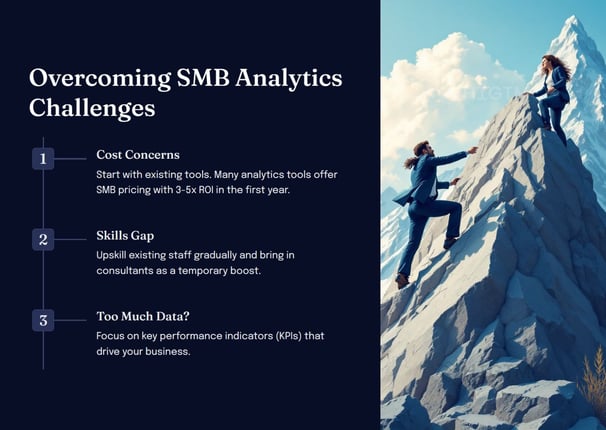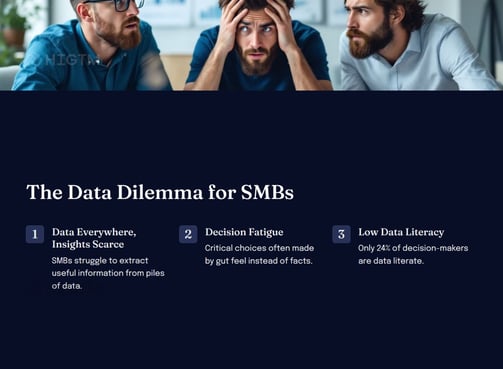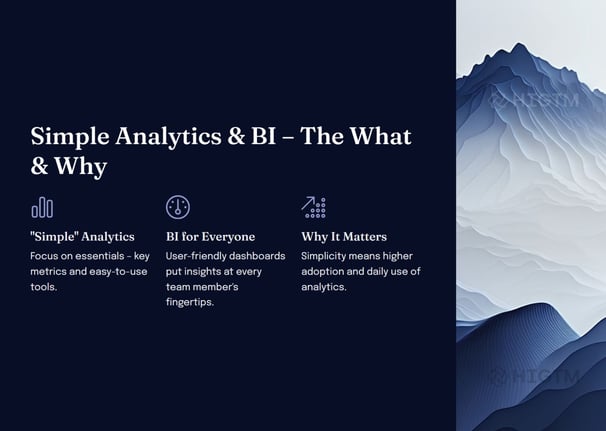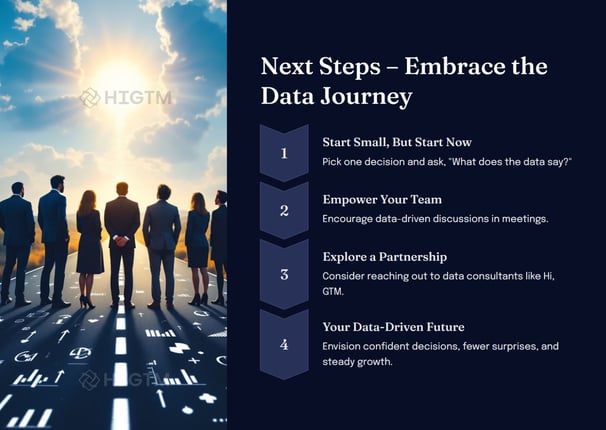41. Simple Analytics & BI – Building Data Literacy in SMBs
Hi, GTM! Welcome to a journey where we transform how your small or mid-sized business thinks about data. Consider this article a friendly chat with a management consultant who genuinely wants to help your business thrive. We’re diving into simple analytics & business intelligence (BI) and why building data literacy is the smartest move you can make this year. If you’ve ever felt overwhelmed by data talk or assumed that advanced analytics are only for big enterprises – this is for you. Let’s show the “big guys” that SMBs can be just as data-driven and savvy, with the right approach.
Q1: FOUNDATIONS OF AI IN SME MANAGEMENT - CHAPTER 2 (DAYS 32–59): DATA & TECH READINESS
Gary Stoyanov PhD
2/10/202515 min read

1. Why SMBs Need to Care About Data (Yes, You!)
In today’s digital economy, data is everywhere – every sale, every customer inquiry, every social media like generates data. For Fortune 500 companies, data has been “the new oil” for years, fueling sophisticated analytics engines. But what about small and medium businesses? Here’s the reality: SMBs are sitting on valuable data goldmines of their own, even if they don’t always realize it.
Survival and Growth: SMBs face fierce competition and thin margins. The businesses that survive and grow are often those making informed decisions. If your competitor down the street is using data to tweak prices, target customers, or streamline operations, and you’re not – they have the edge.
Democratization of Tech: The good news is that technology has leveled the playing field. Affordable cloud-based BI tools and user-friendly analytics platforms mean you don’t need an army of IT staff or a million-dollar budget to start leveraging data. If you can use Excel or run a simple app, you can do analytics.
The Surprising Stats: Still not convinced? Studies have found that only 24% of business decision-makers are considered data literate.
That means three out of four leaders might be missing out on insights hiding in plain sight. No wonder Gartner’s research identified poor data literacy as a top roadblock to success for today’s companies. Imagine the advantage your SMB can have by simply improving data skills across your team – you’d be ahead of 75% of the pack!
2. The State of Data Literacy: A Reality Check
Let’s talk about what data literacy actually means. It’s not about complex math or coding; it’s as basic as understanding the story your data is telling you. If you can interpret a simple bar chart or see a trend in a line graph, you’re practicing data literacy. Unfortunately, many of us have been conditioned to fear the numbers (flashbacks to boring statistics classes, anyone?). The result:
Managers rely on gut feeling because they “don’t trust the data” or don’t know how to crunch it.
Employees shy away from reports, thinking, “I’m not a numbers person.”
Companies invest in fancy BI software that nobody actually uses to its full potential.
In fact, a survey by Accenture found that 75% of managers lack confidence in their ability to interpret data. Think about that – these are bright, experienced people who feel blind when presented with a spreadsheet of figures. And it’s not their fault; most SMBs haven’t trained their staff (or leaders) on data skills. It’s like expecting everyone to ride a bicycle without ever providing a lesson – of course there will be wobbles and scrapes.
Why is this a problem? Because in the modern business world, making decisions without understanding data is like navigating a ship without a compass. You might get to your destination, or you might crash on the rocks – it’s a gamble. On the flip side, if you do invest in data literacy, the rewards are tangible. Data-literate companies are more likely to find ways to cut costs, identify new market opportunities, and react quickly when signals in the data point to change.
3. Simple Analytics & BI: What Does “Simple” Look Like?
When you hear “business intelligence,” if you picture massive dashboards with hundreds of metrics or teams of data scientists building AI algorithms, you’re imagining the high-end (and high-complexity) side of BI. But simple analytics and BI is a different animal – and it’s tailor-made for SMBs. Here’s what it looks like:
Focus on Key Metrics: Rather than boiling the ocean, you identify a handful of key performance indicators (KPIs) that drive your business. For a retail shop, it might be daily sales, foot traffic, and average transaction value. For a small manufacturing company, it could be daily production output, defect rate, and order backlog. The mantra is: start with a few metrics that matter most. Less is more.
User-Friendly Tools: Forget custom-coded, million-dollar software. “Simple BI” means using tools that you can get up and running quickly. This could be an out-of-the-box dashboard from your point-of-sale system, a plug-and-play analytics app that connects to QuickBooks, or even a well-crafted Excel or Google Sheet. Modern BI platforms like Microsoft Power BI, Tableau, or Google Data Studio have free or low-cost versions that are quite intuitive. If your team can drag and drop, they can use these tools.
Clear Visuals and Alerts: Simplicity also means clarity. The goal is to turn data into visuals and signals anyone can grasp. That means charts with obvious trends, red-yellow-green status lights, or email alerts when a number goes out of an expected range. For example, a simple visual: a bar chart of sales this month vs. last month, with each bar labeled clearly. In seconds, you know if you’re pacing above or below where you were. That immediate clarity is powerful.
Quick Insights, Not Perfect Ones: A phrase we love is “better roughly right now than precisely right too late.” Simple analytics favors quick, actionable insight over exhaustive analysis. If your inventory is running low, you want to know now so you can reorder, even if the report isn’t a 100% statistically perfect model. As an SMB, speed and actionability trump sophistication. You can always refine later.
By keeping analytics simple, you lower the barrier to entry. Your team sees that data isn’t some distant technical domain – it’s part of their everyday toolkit. And this is where data literacy naturally grows. The more people use these simple tools, the more comfortable they get. It’s a virtuous cycle: simplicity drives adoption, and adoption drives insight, which drives results.
4. Immediate Impact: Analytics in Action for Key SMB Industries
One of the best ways to illustrate the power of analytics is through examples. Let’s shine a light on a few industries where SMBs play and show how even basic BI can spark big improvements:
4.1 Retail: Stock Smarter, Sell More
Scenario: Jane runs a small chain of boutique grocery stores. She’s not a data guru – her expertise is in finding unique products and providing great customer service. But she started using a simple sales dashboard that came with her point-of-sale system.
Insight: The data revealed a clear weekly pattern: every Friday, there’s a spike in snack and beverage sales (people stocking up for the weekend), but by Sunday afternoon, certain popular items were completely sold out, turning away eager customers.
Action: Armed with this insight, Jane tweaks her inventory ordering – extra snacks before the weekend, and a mid-week mini restock. She also added a Friday afternoon promotion for weekend bundles.
Result: Sales climbed by 10% in those categories, and customers left happier (because they found what they wanted). The investment? Just Jane’s time in looking at a dashboard and making a few calls to her suppliers. This is simple BI at work – no fancy algorithm, just spotting a trend and acting.
4.2 Professional Services: Every Hour Counts
Scenario: Let’s talk about a small IT consulting firm with 25 employees. They bill clients by the hour and juggle multiple projects. The owner, Carlos, kept seeing projects go over budgeted hours, eating into profit. He implemented a basic time-tracking and project dashboard (integrated with their project management tool).
Insight: The data made it clear that projects tended to drift when they went past 8 weeks in duration. Any project longer than that had a 60% chance of using 20% more hours than estimated. Additionally, one type of service (let’s say security audits) consistently had scope creep.
Action: Carlos introduced tighter check-ins at the 6-week mark of projects to course-correct before things went off track. For security audits, he standardized the process and templates to close the scope gap.
Result: Within a quarter, the average project overrun shrank dramatically. On average, each project saved about 15 hours that would have been over-budget – a direct saving, boosting the firm’s bottom line. Without the simple analytics to reveal those patterns, Carlos would still be guessing why projects were running over.
4.3 Manufacturing: From Reactive to Proactive
Scenario: A family-owned manufacturing company produces custom parts with a small fleet of machines. Downtime is a profit-killer for them. They don’t have an IoT-powered smart factory, but they do log machine usage and maintenance in a spreadsheet. They engaged in simple analytics by graphing each machine’s output and downtime incidents over the past year.
Insight: One machine (let’s call it Machine A) showed a pattern: every time it approached 1,000 hours of use since last service, it had a breakdown or needed calibration. The other machines had no such clear pattern.
Action: The team instituted a preventive maintenance schedule for Machine A at 900 hours of use. Basically, they started treating 900 hours as the “service me now” trigger instead of waiting for a failure.
Result: Over the next six months, breakdowns on Machine A dropped to zero. The production schedule became more reliable, orders went out on time, and the stress level on the shop floor went down. A simple line graph analysis saved them countless headaches and kept the revenue flowing steadily.
4.4 Healthcare: Patient Care Meets Data Care
Scenario: A small network of community clinics wants to improve patient satisfaction and throughput. They start collecting a few data points: appointment wait times, number of daily appointments completed vs. missed, and patient feedback ratings.
Insight: Data from the clinics showed that Mondays had the highest no-show rate (people forgetting or skipping after the weekend) and that appointments right after lunch were often running 15 minutes behind schedule on average.
Action: In response, the clinics started doing reminder calls/texts for Monday appointments specifically (to reduce no-shows) and adjusted the doctors’ schedules to have a bit more buffer after lunch. They also shared the patient feedback scores with the staff weekly, highlighting any positive comments (to reinforce good practices) and discussing one area for improvement.
Result: No-show rates dropped by a noticeable percentage (more patients served = more revenue and better community health impact), and patient satisfaction scores in surveys started climbing. Staff even began a friendly competition to have the best feedback each week. None of this required a massive IT overhaul – just collecting a few data points consistently and making small changes.
Across these examples – different industries, different challenges – the common thread is small data, big insight. Each SMB leveraged a modest amount of information and relatively simple analysis to unlock value. The retail and manufacturing examples show immediate financial impact; the professional services and healthcare ones show both financial and quality improvements. And every one of those improvements began with increasing someone’s data literacy: Jane understanding her sales report, Carlos digging into project metrics, the factory team reading a maintenance chart, the clinic managers tracking wait times.
5. Building a Data-Literate Team (Without Overwhelming Everyone)
So, how do you replicate these wins in your own business? It starts with your people. Here’s a straightforward game plan to build data literacy in your SMB:
1. Lead by Example: If you’re an owner or manager, let your team see you using data in decisions. Even something as simple as, “I was looking at our sales numbers from last week, and I noticed X, so I think we should do Y” sets a powerful tone. It says, “We value data here.” When leadership talks data, others follow.
2. Incorporate Data into Regular Meetings: Make it a habit that weekly or monthly meetings include a short data review. For instance, begin sales meetings not just with pipeline talk, but a quick look at last week’s sales dashboard. Or in team stand-ups, share one key metric. Repetition normalizes the act of looking at data. It goes from novel to expected.
3. Offer Bite-Sized Training: You don’t need formal classes (though if you have access, great). Even short internal workshops can help. Perhaps your most Excel-savvy employee can teach others a few tricks for analyzing data. Or bring in a consultant for an afternoon to run a “data literacy 101” session focusing on interpreting basic charts and reports in your context. The key is to remove fear – once people realize a bar chart or pivot table isn’t black magic, they gain confidence.
4. Empower “Data Champions”: Identify a few team members who are enthusiastic about using data and make it part of their role to champion it. Maybe one person from marketing tracks campaign metrics and shares insights, while someone in operations keeps an eye on process stats. These champions act as internal coaches and cheerleaders for data-driven practices. It’s often more relatable for staff to learn from peers.
5. Simplify Data Access: All the enthusiasm in the world won’t help if people can’t easily get to the data. Ensure that whatever tools or reports you have are accessible. Cloud-based dashboards that everyone can log into, or even a shared spreadsheet on Google Drive, can work. Avoid bottlenecks like “only the IT person can run that report.” The more open and self-service the data, the more people will explore it.
6. Set Clear Goals and Celebrate Wins: Set a goal like “reduce order processing time by 20% in next 6 months” and tie it to looking at the data (in this case, maybe weekly order throughput stats). When the goal is met (or progress is made), celebrate it – explicitly credit the use of data in the achievement. “We did it, team! And thanks to tracking our process metrics, we knew exactly where to improve.” This reinforces the behavior you want to see.
By focusing on these steps, you turn data literacy from a vague aspiration into part of your company’s DNA. Remember, building these skills is a journey, not a sprint. People will make mistakes or sometimes misinterpret a number – treat those as coaching moments, not reasons to retreat from data. Over time, you’ll notice more conversations like “Do we have data on that?” or “Let’s check the numbers” – music to a data-informed leader’s ears!
6. The Payoff: Smarter, Faster, Stronger SMB
Let’s zoom out and look at the big picture. Why go through all this effort to build a data culture and employ analytics? Because the results can transform your business.
Consider these outcomes that real data-savvy SMBs are achieving:
Financial Performance: Data-driven SMBs literally make more money. A recent study showed that 65% of highly data-driven SMBs financially outperform their competitors. They’re not necessarily bigger or older – they’re just running smarter, catching issues before they become costly and pouncing on opportunities first.
Efficiency and Savings: When you know where the waste or delay is, you can fix it. Whether it’s trimming a redundant expense after analyzing your spend or speeding up delivery times by analyzing your workflow, these efficiencies add up. One survey of SMBs found that while 67% were spending at least $10,000 a year on data analytics tech and maintenance, a whopping 86% felt they could be using these tools better. Translation: the ROI on better data use is just sitting there, waiting to be grabbed.
Market Agility: SMBs have one superpower that big corporations often lack – agility. When you pair that agility with good data, you become incredibly resilient. If market conditions change or a new trend emerges, a data-savvy SMB will spot the signals in their sales numbers or customer feedback and pivot quickly. It’s like having ears to the ground while your larger competitors are still waiting for the quarterly report to tell them what happened.
Employee Empowerment and Alignment: There’s a less obvious but very cool benefit to all this. When everyone is engaged with data, your team starts to unite around facts and common objectives. Meetings become less about “I think/you think” and more about “What do we see happening? How do we respond?”. It reduces friction and subjective debates. Plus, employees start feeling more ownership – after all, if they can see the score (the metrics) and influence it, work becomes a bit like a game where everyone wants to win. It’s motivating to see your impact, say, in improving customer satisfaction scores or hitting a sales target, right there on the dashboard.






7. Hi-GTM vs. The Big Guys: A Partner for the Little (but Mighty) Guys
You might be thinking, “This all sounds great, but where do I start if I need a helping hand?” This is where partnering with the right consultants or service providers comes in. There are huge consulting firms out there – Gartner, for example, will happily sell you a report on the latest analytics trends; Deloitte or Accenture can set up a data warehouse for you. But often, those solutions are overkill (and overpriced) for SMBs.
Enter Hi, GTM – which stands for High-Impact Go-To-Market (our friendly way of saying hello to growth). We chose the name because we believe in a warm, personal approach to consulting. When we say “Hi,” we mean it – we start by listening, getting to know your business as if it were our own.
Here’s how we position ourselves against the big firms and why that matters for you:
SMB Specialists: Unlike generalist big firms, we focus on small and medium businesses. We understand the constraints (budget, time, people) and we also know the incredible potential. We’ve helped retailers, professional services companies, manufacturers, and healthcare SMBs – so we speak your language.
No One-Size-Fits-All: Big consulting might roll in with a templated solution. We don’t. Your data journey will be unique. Maybe you already have software you underutilize – we’ll start there. Maybe you have nothing in place – we’ll find a lightweight solution that fits. Perhaps you need training more than tech – we can do that too. Our approach is tailored, like a suit that actually fits instead of something off the rack.
Friendly (“Hi!”) and Approachable: We pride ourselves on being the opposite of stuffy. “Hi, GTM” isn’t just our brand, it’s our vibe. We want you and your team to feel at ease asking any question. There’s no dumb question in data literacy. Don’t know what a term means? We’ll explain it over a coffee chat, not a high-pressure boardroom presentation. Our goal is to make you comfortable with analytics, not to intimidate or overwhelm.
Quick Wins Philosophy: We measure our success in the quick wins we can deliver for you, especially early on. Sure, we love long-term partnerships, but we know you need to see results fast. In our consulting projects, we always identify one or two immediate areas where data can make a difference. Maybe it’s setting up a daily email report of key metrics or uncovering why product X isn’t selling as well as product Y. We aim for those wins in weeks, not months. The momentum (and often the revenue boost) from quick wins helps fund and justify the longer-term improvements.
Knowledge Transfer: We’re not in the business of making you dependent on us. The big firms might set up a complex system that you constantly need them to tweak. We’d rather empower your team to manage and use the solutions we implement. Think of us as coaches – we’ll train your “players” to excel at the data game. When our engagement ends, you shouldn’t just have better dashboards – you should have a better, smarter team.
By positioning HIGTM in this way, we aim to be the go-to partner for SMBs looking to unlock their data potential without the fuss and heavy expense of traditional consulting. We wear our SMB advocacy on our sleeve, and we’re proud to fill this niche.


8. Conclusion: Embrace the Data Journey Today
We’ve covered a lot of ground. From understanding why data literacy is an urgent need, to seeing how simple analytics can spark change in various SMB industries, to laying out how you can cultivate a data-driven culture, and finally how Hi, GTM (or a partner like us) can help you outpace the competition.
The bottom line is this: analytics and BI are not luxuries for big business – they are necessities for small business success. And they’re within your reach. Every trend in technology and cost is in your favor – tools are cheaper, data is more abundant, and the benefits are clearer than ever. A Forrester study even found that SMBs implementing data and analytics strategically often see a two- to six-fold return on their investments within the first year. Where else can you get that kind of payoff?
Imagine your business six months from now. You and your team start the day by glancing at a simple dashboard tailored to your goals. It highlights a potential issue – say, a dip in customer inquiries this week. Because you caught it early, you huddle and brainstorm a quick promotion to re-ignite interest, or maybe double-check if a marketing channel had an outage. Problem solved, opportunity seized – all before it really hurt your bottom line. That’s a day in the life of a data-driven SMB. Fewer surprises, more proactive moves, and a sense of control amid the market chaos.
No one is saying intuition and experience don’t matter. They do, deeply. But when you augment your hard-earned business savvy with solid data insights, you get the best of both worlds. It’s like having two engines on your plane instead of one.
So here’s our friendly challenge to you: say “Hi” to your data. Greet it like you would an old friend – get familiar, check in with it regularly, listen to what it has to say. Nurture your team’s curiosity about the numbers. Start small, celebrate the wins, and build on them.
And if at any point you want a co-pilot on this journey, remember that we at Hi, GTM are just a friendly “hello” away. We’re passionate about translating big-firm analytics know-how into small-business game-changers.
Your SMB can absolutely become a data-informed, analytics-empowered powerhouse. The sooner you start building that data literacy and embracing simple analytics, the sooner you’ll see the results – in efficiency, in growth, and in the confidence of your decisions. The path to smarter business isn’t a mystery reserved for others; it’s right here, ready for you to take.
Here’s to a future where your decisions are smarter, your actions are faster, and your business is stronger – all thanks to a little help from data. 🚀
(Thank you for reading! If you’re ready to boost your data literacy or need guidance on analytics, reach out to us at Hi-GTM – we’re here to help SMBs turn data into results, one friendly chat at a time.)
Turn AI into ROI — Win Faster with HIGTM.
Consult with us to discuss how to manage and grow your business operations with AI.
© 2025 HIGTM. All rights reserved.
